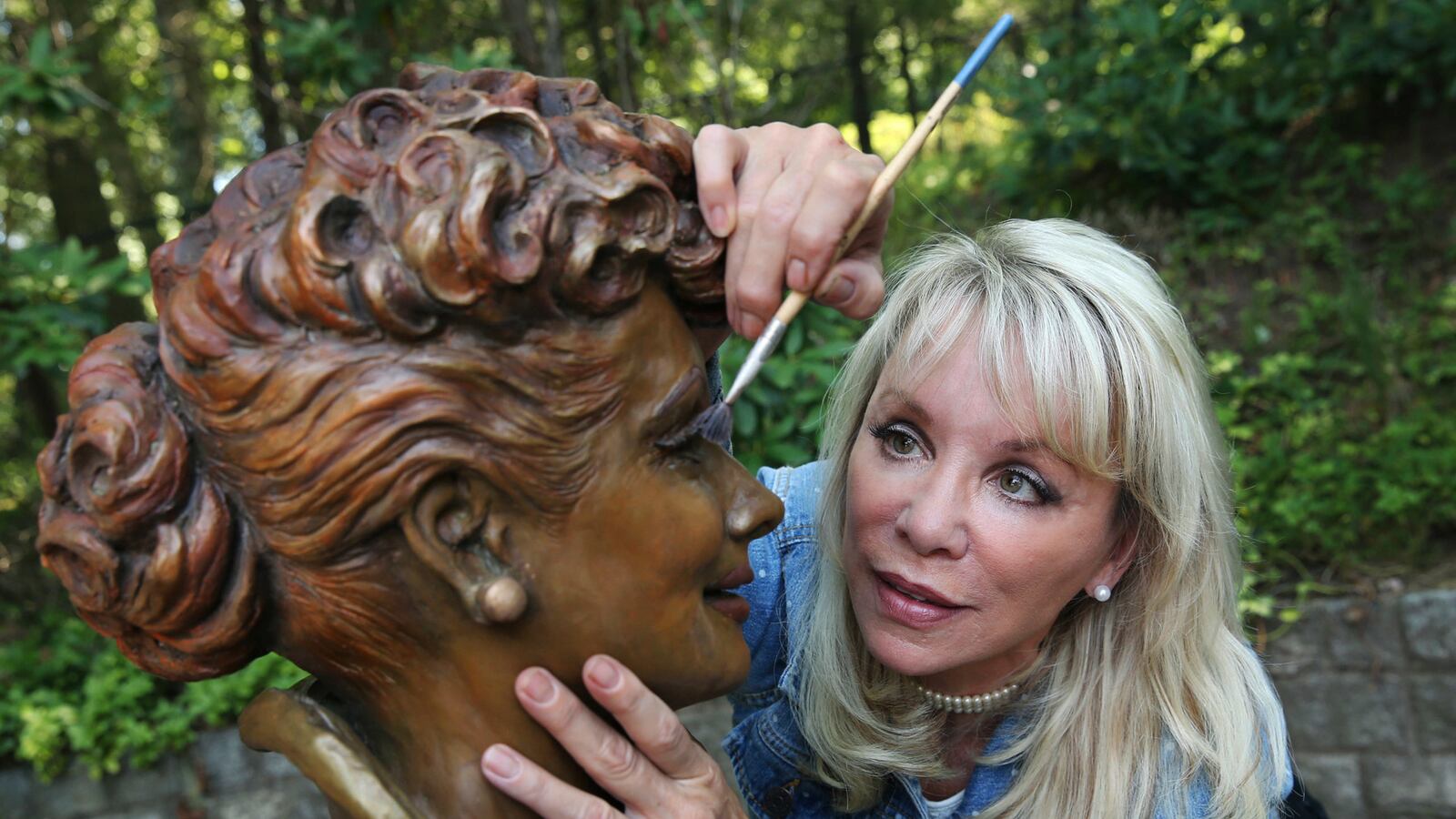There are now two bronze sculptures of Lucille Ball in the memorial park named after the iconic comedienne in her childhood home town of Celoron, New York.
The two statues stand on the same stretch of path, 75 yards from one another. The first, created in 2009 by Dave Poulin and made notorious on social media in 2015, was nicknamed “Scary Lucy” because of her bug-eyed expression and toothy grin.

Poulin’s sculpture caused such an outcry that the authorities in Celoron—population: approximately 1,250—began looking for another sculptor to craft a replacement statue, even as “Scary Lucy” became a major tourist attraction in her own right.
The commission for the new sculpture went to Carolyn D. Palmer and her sculpture—not nicknamed “Friendly Lucy,” but simply “Lucy,” according to Mayor Scott Schrecengost—was unveiled on Aug. 6 on what would have been Ball’s 105th birthday.
The response to Palmer’s sculpture has been almost wholly positive. Her Lucy stands atop her “Hollywood star,” is dressed in a polka dot frock which is captured as if blowing in the wind. She sports tight ringlets in her hair, has a coquettish hand on her hip, a purse hooked around her wrist, and a mischievous smile on her face.
“It was very intimidating to take on something that had such high stakes,” Palmer told The Daily Beast. “I weighed out the consequences and just said, ‘I’m going for it.’ I was extremely nervous right up to the minute of unveiling. When I heard the positive ‘oohs’ and ‘ahhs,’ I thought, ‘Oh my goodness, thank God.’”
Prior to that, “I was feeling so scared,” Palmer said. “I was frightened because the fans are so devoted to her. Just 10 days before, a man called me screaming at me, ‘How dare you?’ thinking I had created ‘Scary Lucy.’” When Palmer explained she wasn’t the artist of that Lucy, the gentleman apologized.
Palmer said fans’ expectations inspired, rather than weighed upon her. “I thought, ‘I’ve got to bring you out Lucy in the most lovable way.”
Of Poulin’s sculpture, Palmer said, “People took it personally, rather than as a piece of art. Her fans see Lucy as a god, and they felt he had desecrated her image. I felt terrible for the other artist. I do want to call him and talk to him now. The world has been a little tough on him, and harsh. I really don’t want to criticize it. As an artist, everyone can understand someone else’s art. You don’t have to care for it, but you have to acknowledge it’s what the artist did.”

Schrecengost noted, more brutally, of the furor around “Scary Lucy”: “Everyone wanted it taken down and wanted a new statue made.”
Schrecengost told The Daily Beast he and Celoron’s previous mayor had both contacted Poulin before “Scary Lucy” became an online sensation, asking him to make changes to the figure.
“He told us he wouldn’t do anything with the statue unless we paid him,” Schrecengost said. When it became a big issue, he said would do it for free. I said no. He had his opportunity, he didn’t step up and fulfill it.
“His last comment to me was: ‘If you can’t come up with the money and nobody likes it, then take it down and put it in storage. At that point, my determination was that I wouldn‘t hire him to do any type of work.”
Poulin did not respond to requests for comment from The Daily Beast.
Of the changes asked of Poulin to be made to his original sculpture, Schrecengost said, “We figured with the mouth closed it wouldn’t have been so bad. The eyes weren’t right. The cheekbones weren’t right. A lot of the facial features just weren’t correct. We didn‘t know if it could be done or not. Talking to other artists, they said if you took it off at the neck and redid it, it still wouldn’t look right.”
Being “nowhere near a professional when it comes to the art world,” led Schrecengost to form a committee which sifted the applications of around 67 sculptors who pitched to make the second Lucy statue.
As that process continued, Scary Lucy’s popularity accelerated.

“She has become an icon of her own,” Schrecengost said. “Since a year-and-a-half ago, when this went viral, we’ve had thousands of people show up from all over the world and take pictures with her. So we decided—with the popularity of it, and the fact that it is a kind of icon in its own right—to relocate it in the park. That way people can come and look at both.”
The new Lucy sculpture was partly funded by a $20,000 donation by Boston area car magnate Ernie Boch Jr., who first offered the cash to buy “Scary Lucy,” and then—when told she wasn’t for sale—to fund the new statue.
“I’ve always been a Lucille Ball fan from being a kid when she was on the Three Stooges show and did movies with Bob Hope,” Boch told The Daily Beast. “As a kid, I thought she was great. The first statue was just horrific. It was scary. It didn‘t look like Lucille Ball. When you take a step back, you realize, in its own right, it’s a great statue—just not of Lucille Ball.”
Boch told The Daily Beast he had called the authorities in Celoron and offered to buy “Scary Lucy.” He was told he could not. He asked if the village planned to replace it, and was told it did but could not raise enough in funds. “I said, ‘Forget it, I’ll give you twenty grand for the statue’ and that’s how it all started.”
Schrecengost said that four other anonymous donors joined Boch to fund Palmer’s statue (Schrecengost said he did not know what the final sculpture cost).
If Boch disliked “Scary Lucy” so much why did he want to buy her?
“I have a statue garden and I was going to put her there,” he said, noting he was a big fan of the Museum of Bad Art in Brookline and Somerville, Massachusetts. “It’s a museum of all the worst possible art you could ever see. It’s fantastic. Look at Sharknado 4: It’s so bad you absolutely love it.”
Boch did not have any say in Palmer’s new Lucy, he told The Daily Beast, but opined, “It captures Lucy, and is a fine tribute. It’s actually beautiful. The dress is spectacular.” Of the two sculptures, Schrecengost said bluntly, “One is Lucy and the other one is…another sculptor’s opinion of Lucy, I guess I would call it.”
Palmer said she had total artistic freedom in creating Lucy mark two, apart from—for copyright issues—drawing on anything from a specific episode of I Love Lucy. She sent early photographs to the authorities in Celoron, but they made no demands on her. She hired models to walk around as Lucy, and became inspired by the pose now cast in bronze, with its “confidence, playfulness, a little peacocking. I got into Lucy’s personality and spirit.”
Palmer watched so many reruns of classic episodes of I Love Lucy that she had to turn it off. “I was enjoying it so much, I thought, ‘I’m never going to get this done.’” One episode featured Lucy becoming a sculptor herself which was “uncanny” for Palmer to observe.
Palmer calls her completed sculpture her “nine-month baby,” the hardest part—knowing the piece would stand in nature—was imagining the kaleidoscope of shadows that would play over her sculpture’s facial features.
Prior to the unveiling of Palmer’s sculpture, Schrecengost said he had alighted upon families from Hungary, California, Pittsburgh, Delaware, and the Bronx all looking for “Scary Lucy.” They were unaware that a new “Lucy” sculpture was about to be revealed to the world.
“My heart was pounding,” Palmer said of the moment the tarp was taken off her statue. “There were around a thousand people there. Friends sent me videos of people gasping. Relatives of Lucy’s were there, and they had tears coming out of their eyes. “When I saw their response, I said, ‘Gosh, I’ve succeeded for the fans and her family. I’m not sure about the fine arts world.’”
“Everybody was overwhelmed,” said Schrecengost. “It’s a gorgeous piece. Everybody likes it. There are no complaints whatsoever. Carolyn Palmer made Lucy look glamorous, sophisticated, and it’s just beautiful. She’s got tints and colors. It’s so creative: just the way it pops.
“She is our icon and the first lady of comedy. It’s just nice to have a nice representation of her. You can stand here and look across the street and say, ‘That is a spitting image of Lucille Ball.’”
There will, said Schrecengost, be no more “Lucys” commissioned. “I’m leaving it just the way it is,” he said, laughing. “Everybody is overjoyed with Carolyn Palmer’s sculpture. Now we can put all of this behind us and move on. Carolyn did a fantastic job. She is a great artist. I can’t say enough good things about her.”
Since the unveiling, “it’s just been crazy,” he added. “There have been 40 to 50 people at a time from all over.”
What, ultimately, makes the new statue better than the older one, I asked Mayor Schrecengost.
“It looks like Lucy,” he said, and then roared with laughter.
One elderly woman approached Palmer after the unveiling, and told her, “I’ve been so hurt by the other statue. I can go in peace knowing that Lucy will be memorialized in a beautiful way.” The lady’s words made Palmer realize “how much emotion is behind this piece. Lucille Ball was an icon loved by very many.”
On Monday afternoon, Palmer was “very relieved” to be going home, to rest, and oversee the instalment of her next project: a bronze statue of Pope Francis which will stand in St Patrick’s Cathedral in New York City.
She has captured him looking directly at the spectator, a smile on his face to evoke the very human connection he seems to make with people. “I feel his presence very strongly, looking at the sculpture, and others say they feel the same. It’s an honor to do him, as it was to do Lucy.”
As for the two Lucys now standing tall in the park—“Scary Lucy” facing north, and “Lucy” facing south—Palmer thinks their dual presence tells its own story. “To just discard her or sell her, that would be almost sacrilegious,” she says of Poulin’s sculpture. “She put Celoron on the map, and she was responsible for the birth of the new Lucy. Both have their place.”





